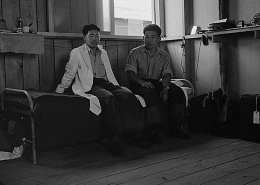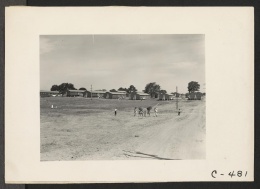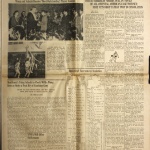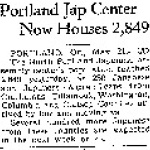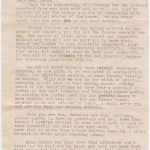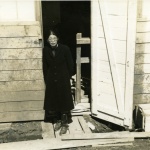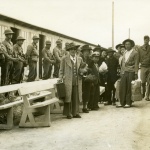Sacramento (detention facility)
| US Gov Name | Sacramento Assembly Center, California |
|---|---|
| Facility Type | Temporary Assembly Center |
| Administrative Agency | Wartime Civil Control Administration |
| Location | Sacramento, California (38.5667 lat, -121.4833 lng) |
| Date Opened | May 6, 1942 |
| Date Closed | June 26, 1942 |
| Population Description | Held people from Sacramento and San Joaquin Counties, California. |
| General Description | Located about fourteen miles northeast of downtown Sacramento, California. |
| Peak Population | 4,739 (1942-05-30) |
| Exit Destination | Tule Lake |
| National Park Service Info | |
Open for just fifty-two days—but with most inmates spending only around a month there—the Sacramento Assembly Center had the shortest lifespan of any " assembly center " other than Mayer , Arizona. The inmate population that peaked at 4,739 came almost entirely from the Sacramento area, and conflicts and discord within that community came into the camp, where discord between the appointed inmate leadership and the general population emerged. Inmates also faced particularly poor conditions including pit latrines and buildings that were misshapen due to the uneven ground and poor construction, as well as a camp that was largely unfinished as inmates moved in. Essentially the entire population of the camp—which was also known as "Walerga"—was transferred to Tule Lake by the end of June 1942.
Site History/Layout/Facilities
The Sacramento/Walerga Assembly Center was built on the site of the Walerga Advanced Depot, a former migrant workers camp about fourteen miles northeast of Sacramento. Built on what one inmate describes as "kind of a rolling plain" that had "ups and downs all over the center," the camp was plagued with building quality issues throughout its life. [1]
The staff, including manager Gene Kenyon, moved into the camp on April 11. In an April 26 report to the WCCA office, Kenyon noted the many flaws he saw in the camp:
Buildings poorly constructed, footings inadequate. Floors weak. Structures going badly out of shape because of settlement and shrinking. Have lost portions of roofs of about 100 buildings. These have been nearly all replaced, ready for the next wind. Maintenance costs throughout will be high.
In a May 13 report, he wrote the that Army Corps of Engineers personnel arrived "to do certain work in connection with the camp," but complained that it would have been much better had they done this work before the arrival of inmates. This work included fixing "about 100 barracks, badly warped because of poor footings and green lumber" as well as fixes to the bathhouses, latrines, cook houses, hospital and water supply. In a May 28 report, Kenyon wrote that these changes "are now being made some forty days later after the evacuees have been inducted." [2]
The camp was divided into five large blocks which each had around forty barracks along with four bathhouses, six latrines (two each for men, women, and children), and a laundry room. The barracks were the standard 20 x 100 and were subdivided in most cases into five "apartments," two each of 16 and 24 foot widths and one 20 feet wide. As was typical with assembly centers, the room dividers did not go all the way to the roof, allowing sound to travel the length of the barrack. Rooms were furnished with one cot per person. About 2/3 of the inmates received cotton mattresses, while the rest received sacks that had to be filled with straw. In his memoir, former inmate Noburu Shirai remembered that "[g]rass grew through the floorboards of our room, and the cracks between the dividing wallboards allowed us to see our neighbors. We had no privacy." [3]
There were two mess halls in each block, a total of ten. Since each was required to serve some 500 people, meals were served in three shifts. Inmates were given cards that assigned inmates to a particular mess hall and shift. In a 1945 interview, Dave Okada said that he "had to wait in long lines before we were served any meals." While there was "confusion" in the distribution of food, he recalled that "the food was fairly substantial but nothing fancy." [4]
In his May 28 report, Kenyon noted a number of issues with the mess halls and kitchens: "The cook houses had a single floor and were not screened. Flies could not have been kept out.... Sufficient sink space was not available.... Refrigeration facilities within the cook house are inadequate...." These things were slowly being fixed. [5]
The head chef was Frank Pilcher, who was a local hire. He soon gained a reputation among inmates for his aggressive efforts to minimize feeding costs at the price of sometimes not having enough food and for having anti-Japanese sentiments. Rumors of graft also circulated. He later became part of the mess hall staff at Tule Lake, where former Walerga inmates organized a petition signed by 9,000 that resulted in his resignation. [6]
The latrines were pit toilets that initially lacked screens or tight covers to keep flies at bay. The temperature for the showers could not be controlled by the user, and the shower heads were too high for many of the inmates. As with other parts of the camp, fixes for these problems were ongoing while the camp was occupied. [7]
Camp Population
Nearly the entire population of Sacramento/Walerga came from city of Sacramento and the surrounding area. Among the surrounding areas was Florin/Elk Grove, a heavily Japanese American area just south of Sacramento that had the misfortune to be split up and sent to several different camps. While the first advance groups arrived on May 6, the bulk of the population came between May 13 and 21. The peak population of the camp of 4,739 took place on May 30. There were fifteen births and one death. [8]
| Exclusion Order # | Deadline | Location | Number |
| 52 | May 16 | City of Sacramento | 3,847 |
| 70 | May 21 | North San Joaquin County; Lodi | 286 |
| 75 | May 20 | Southwest Sacramento County | 576 |
Source: John L. Dewitt, Final Report: Japanese Evacuation from the West Coast, 1942 (Washington D.C.: U.S. Army, Western Defense Command), 363–66. Exclusion orders with fewer than twenty-five inductees not listed. Deadline dates come from the actual exclusion order posters, which can be found in The Japanese American Evacuation and Resettlement: A Digital Archive, Bancroft Library, UC Berkeley, http://digitalassets.lib.berkeley.edu/jarda/ucb/text/cubanc6714_b016b01_0001_1.pdf and http://digitalassets.lib.berkeley.edu/jarda/ucb/text/cubanc6714_b016b01_0001_2.pdf .
| Arrival Date | Number of Families |
| May 6 | 42 |
| May 8 | 59 |
| May 9 | 3 |
| May 13 | 281 |
| May 14 | 241 |
| May 15 | 480 |
| May 16 | 24 |
| May 19 | 143 |
| May 20 | 24 |
| May 21 | 139 |
Note that figures given are the number of families; the number of individuals would be approximately that number multiplied by 3.1. Source: Special Report of Secretary of War, Management Section, May 28, 1942, May 28 report, 1.230 Reports, various, 1.2 Center Manager File, 1 Administrative Records, Sacramento Center, Reel 1, NARA San Bruno.
In a 1943 study,
Japanese American Evacuation and Resettlement Study
(JERS) researcher
Robert H. Billigmeier
noted that the large number of people removed from Sacramento was some 1,000 more than the population listed in the 1940 Census. Much of this population growth, he wrote, were those who "crowded into the city's Japanese district from surrounding rural areas before the evacuation occurred," presumably to join family or friends in an effort to be sent to the same camp. He added that "Sacramento was the only city in
Military Area 1
which showed a large increase in Japanese population according to the Change of Residence cards of the Wartime Civil Control Administration."
[9]
Contemporaneous accounts noted the resentment a large portion of the inmate population had towards the appointed inmate leaders of the camp, in particular Dr. George Iki, the supervising physician at the camp hospital, and lawyer Walter Tsukamoto along with their JACL -connected associates, who were accused, among other things, of taking advantage of community members by charging exorbitantly for professional services prior to the roundup, for saving the best jobs at the camp for themselves and their friends and family, and for being overly deferential to the white camp administrators. While making no judgment on whether these widely believed allegations were true, JERS researcher S. Frank Miyamoto concluded that there was "violent hostility to the JACL" at the camp and also wrote that former Sacramento inmates vandalized the luggage of Iki, Tsukamoto, and others during the transfer to Tule Lake. In a 1944 interview, Dave Okada cited near "open conflict" over rumors about "Dr. Iki and his clique" and claimed that had the camp population not been sent to Tule Lake, that "there would have been a blow-up in our center similar to what occurred at Santa Anita ." These tensions spilled over to Tule Lake and shaped camp politics there. [10]
| Departure Date | Number |
| June 15 | 498 |
| June 16 | 504 |
| June 17 | 512 |
| June 18 | 494 |
| June 19 | 497 |
| June 20 | 499 |
| June 21 | 509 |
| June 22 | 512 |
| June 23 | 545 |
| June 26 | 85 |
Source: John L. Dewitt, Final Report: Japanese Evacuation from the West Coast, 1942 (Washington D.C.: U.S. Army, Western Defense Command), 282–84.
Essentially the entire population of Sacramento/Walerga was transferred to Tule Lake from mid- to late June 1942. [11]
Staffing
Gene Kenyon was the manager of the Sacramento/Walerga camp for the entirety of its short lifespan. In the final issues of the Walerga Wasp newspaper, the inmate council he had appointed issued a resolution thanking Kenyon "for the very kind and sympathetic treatment accorded us since our evacuation to this Center." [12]
Other management staff included:
John C. North, Supervisor of Works & Maintenance
Myron Bear, Supervisor of Supplies
Charles T. Paine, Supervisor of Service
Robert Argall, Supervisor of Housing & Feeding
Samuel Andrews, Chief Steward
William Laracy, Fire Chief
J. G. Hooks, Chief of Police
Ferdinand Ambrose, Supervisor of Recreation
George Rodgers, Center Store Manager
[13]
As was the case with other assembly centers, much of the staff came from the ranks of the WPA. Kenyon and his support staff, North, and Bear came from the WPA Sacramento Office, while Paine had worked for the State of California. The others were hired locally. [14]
Institutions/Camp Life
Community Government
Soon after the arrival of the inmates, Kenyon appointed a "Japanese council" of five that included Harry Masaki, Jun Miyakawa, Dr. Goro Muromoto, Dr. George Iki, and Walter Tsukamoto. The group met for the first time on May 16. In a May 20 report to the WCCA, Kenyon wrote that the council members "are all highly intelligent men and have already given a considerable amount of assistance." [15]
As noted above, there was widespread dissatisfaction with both the council members and the way they had been chosen. All the council members except for Iki—who was an Issei but a longtime resident—were associated with the JACL and the perception was that the council "practically ran the camps and the residents resented this tight-knit control," according to inmate Dave Okada, who also recalled that "[s]everal petitions were filed asking for a more democratic council and a voice for the people, but these requests were ignored by the council and the WCCA." Another inmate told JERS field worker Miyamoto that these leaders were rumored to be "taking graft and all that sort of thing," in particular, because inmates at Sacramento did not receive clothing allowances as did inmates at many other assembly centers. [16]
No doubt due in the part to the short lifespan of the camp, no elections for any sort of community government body were ever held.
Education
Given the short lifespan of the camp and the lack of facilities, there was only a limited educational program. About 260 young children under age ten met in outdoor classes "all over the grassy slope" at what was dubbed "Oak Grove Elementary," while around 600 middle and high school students attended five hours of classes in "three warehouses, induction building, and forty-two benches" taught by one director and ten assistants. Three inmate teachers offered English classes for adults. [17]
Medical Facilities
The camp hospital consisted of three barrack buildings. One was used as an out-patient clinic, including medical and dental exam and treatment rooms, a pharmacy and offices; the other two were used as infirmaries. All seemed to be still under construction to some degree as inmates arrived the camp. A number of patients were sent to the Sacramento County Hospital due to what Kenyon called "inadequate infirmary facilities." [18]
Dr. George Iki was the chief-of-staff and superintendent and one of four doctors at the camp. The hospital staff also included three R.N.'s, a pharmacist, a dietician, and four dentists. Since he also was one of the appointed "Japanese council," Iki was a controversial figure. One co-worker claimed that he "was more interested in politics; he was trying to become Mayor of Walerga" and cited his inattention to patients, while another cited the difficult conditions inmate doctors faced and Iki's own illness during which he tried to continue to work. [19]
Library
The camp library occupied a space in "a bare warehouse with boxes and benches" and was led by Nori Shiba, a former employee of the Sacramento City Library, along with two other staff members. Its circulation was about one hundred books and ninety magazines a day. [20]
Newspaper
Ten issues of the Walerga Wasp newspaper appeared between May 9—when the bulk of the population had yet to arrive—and June 14, 1942. The editor throughout was Jobo Nakamura, a well-known Nisei journalist before and after the war. Publication director Howard Imazeki later edited the Tule Lake newspaper and served for many years as the English section editor of the Hokubei Mainichi newspaper in San Francisco. Other editorial staff members included Arthur Morimitsu, Stanley Sugiyama, Frances Okamoto, and art editor Paul Takahashi. As was the case with all assembly center newspapers, the Wasp operated under the supervision of camp management. [21]
Religion
Services were held for Catholics, Protestants, and Buddhists, with a total attendance of about 1,500. The services were held in unused warehouse and induction buildings which were equipped with a donated piano and organ. [22]
Recreation
Organized recreation was limited given the short life of the camp. Softball was a popular pastime for players and spectators as were Camp Sings. Boy Scout and Camp Fire Girl troops formed. [23]
Store/Canteen
The store opened on May 21 and was open from 10 am to 4 pm. Popular store products included ice cream, soda, candy, and cigarettes. George Rodgers managed the store and its staff of twelve inmates. In a May 28 report, Kenyon cited the canteen as "the most popular place at the Center." [24]
Visitors
Visiting days were Wednesday, Saturday, Sunday from 2 to 4; no information on the logistics of visitation were found. [25]
Other
A Post Office branch in the camp was managed by a white postmaster and staffed by eight inmate employees. It was open from 10 to 4 on weekdays. Inmate mail carriers delivered mail to the barracks each morning. [26]
The Fire Department was staffed by a white chief and two white assistant chiefs, one of whom was on duty at all times. They were augmented by a volunteer staff of twelve inmates, along with ten volunteers in each of the five blocks who were responsible for reporting fires in those blocks. [27]
An Information Office ran out of the store and was staffed by an inmate manager and three others. They also ran a lost and found. [28]
Chronology
May 6
First group of 129 "volunteers" arrive. Two days later, another 260, who are family members of the first group, arrive.
May 9
First issue of the
Walerga Press
is published.
First camp wedding takes place. Shizuye Nishimura and Hiroshi Takahashi are given permission to go to the County Hall to tie the knot.
May 15
Post office opens.
May 18
Preschool recreation center opens "at the oak grove near the hospital"; directors are Mary Machida, Nancy Fukuhara, and Mary Ishii.
May 20
First community songfest attended by 1,500 at the Induction building court. "Despite the lack of benches, lighting, public address system, and other facilities, the first mass activity of its kind in the Center was a huge success."
May 21
Canteen opens for business.
May 25
First camp baby born to Mr. and Mrs. Soishi Nakayama of Isleton.
May 29
Twenty cases of diarrhea lead to investigation of food supply.
June 2
36 inmates (including one woman) depart for Twin Falls, Idaho, for sugar beet work; another 22 leave on June 8.
June 9
First group of 13 depart for Tule Lake. These include Dr. Henry Sugiyama and his family.
Sixty-five graduating seniors from Sacramento High receive their diplomas by mail.
June 13
Final Camp Sing draws 2,000 to Warehouse 24.
June 14
Final issue of the
Wasp
is published.
Quotes
"And those lines! To eat, to buy scripts, for mails and stamps, for typhoid shots—each time we stood in line despite the heat or wind. At least it strengthened our feet."
Eugene Okada, 1942
[29]
"I think Walerga was worst of all camps. It was the crudest, it was... I've never had to go use an outhouse with twelve other people."
Betty Fujimoto Kashiwagi, 2009
[30]
"Walerga wasn't so bad. I didn't expect anything good so I wasn't too shocked by the lousy place. I had worked in farms before so I was able to tolerate the outhouses."
Akira Omachi, 1943
[31]
"What annoyed me the most was that the next door family turned their radio on loudly at 6:00 o'clock in the morning in order to listen to a cowboy program. The thin partition between barracks didn't reach the ceiling so we could hear everything that was said."
Dave Okada, 1945
[32]
"Walerga was the worst camp that I ever stayed in. It was a real dirty place and when we arrived we found that there were big cracks in the walls of the barracks. That's why we had plenty of ventilation. We weren't used to that kind of life so we all got diahhrea (sic). At Walerga we only had those outhouses like they have in the country and there wasn't any modern plumbing at all. It was pretty bad when everyone got diahhrea. The living conditions were lousy. They crowded us in like sardines there. I thought that it was one hell of a hole and I knew I wouldn't like it at all. It was a good thing that we only stayed there for about a month."
Hideo Abe Hashimoto, 1945
[33]
"When we arrived in the center, we were of the opinion that the Japanese people were industrious, intelligent, accurate, and dependable. It is now our belief that in the vast majority of cases they possess none of these attributes, except in isolated instances. It is therefore our recommendation that a larger number of Caucasian people be employed in the administrative office and in the various warehouses."
Gene Kenyon, 1942
[34]
Aftermath
On December 1, 1942, Camp Kohler was dedicated at the same site as a Signal Corps Replacement Center and later served as a transit depot for the air force. Ironically, Japanese Americans would once again populate the barracks at this site starting in November 1945, when Camp Kohler was made available to those returning to the area from inland concentration camps. Facing severe housing shortage at the time, some 234 families ended up staying at Camp Kohler. Much of the camp was destroyed by fire in June of 1947. The area is now part of the Foothill Farms-North Highlands residential subdivision in Sacramento. [35]
Sacramento Assembly Center was one of the twelve California temporary detention centers to share California Historical Landmark #934, so named in 1980. In 1979, work on a park that included part of the assembly center site commenced. [36]
On February 28, 1987, a bronze marker was dedicated at Walerga Park, mounted on a 6,000 pound boulder at the northwest corner of Palm Avenue and College Oak Drive. Titled "Lest We Forget," the inscription on the monument reads:
Lest We Forget
Walerga Assembly Center was established by the United States at the outset of WW2 to assemble and temporarily detain without charge or trial, 4,739 Sacramento residents solely because of their Japanese ancestry. Approximately 120,000 persons were uprooted from their West Coast homes and interned in 10 War Relocation Centers. Over two-thirds were American citizens by birth.
Given the opportunity, many thousands left the 10 centers to work on farms and in war industries or to serve with valor in the armed forces. Their acts and deeds gave living proof that Americanism is a matter of mind and heart, not a matter of race or ancestry. May this memorial remind all Americans to be alert so that such injustices never recur.
Camp Kohler succeeded Walerga Assembly Center with the departure of the last Japanese American internees in late June 1942. After being taken over by the Army Signal Corps, the camp's facilities greatly expanded to house and train military personnel. Camp Kohler became one of the Corps' three principal training centers during WW2.
Dedicated by Japanese American Community of Sacramento in cooperation with Sunrise Recreation and Park District.
The boulder was donated by Mr. and Mrs. George Yamasaki of Auburn; labor for the shade structure donated by Jack Akabori, a local contractor; the structure was designed by Roy Imai of Imai-Wang Associates. [37]
Alumni
Mitsuye Endo
, plaintiff in landmark lawsuit
Howard Imazeki
, journalist
Tommy Kono
, Olympic champion weightlifter
Sidney Kosasa
, businessman
Tetsujiro "Tex" Nakamura, attorney
Yuki Shimoda
actor
Sab Shimono
, actor
Walter Tsukamoto
, attorney
For More Information
Burton, Jeffery F., Mary M. Farrell, Florence B. Lord, and Richard W. Lord. Confinement and Ethnicity: An Overview of World War II Japanese American Relocation Sites . Western Archeological and Conservation Center, National Park Service, 1999, 2000. Seattle: University of Washington Press, 2002. The Sacramento section of 2000 version accessible online at http://www.nps.gov/parkhistory/online_books/anthropology74/ce16i.htm .
Sacramento (Walerga) Assembly Center video. Japanese American Memorial Pilgrimages, 2018.
Footnotes
- ↑ WCCA Press Release, Mar. 28, 1942, John M. Flaherty Collection of Japanese Internment Records, MSS-2006-05-02, San José State University Library, Special Collections & Archives; Jeffrey F. Burton, et al., Confinement and Ethnicity: An Overview of World War II Japanese American Relocation Sites (Seattle: University of Washington Press, 2002), 366–68; Kiyoshi Tanaka interview by Frank Miyamoto, Aug. 18, 1944, p. 1, The Japanese American Evacuation and Resettlement: A Digital Archive, The Bancroft Library, University of California Berkeley, BANC MSS 67/14 c, folder T1.8403, http://cdn.calisphere.org/data/28722/24/bk0013c5024/files/bk0013c5024-FID1.pdf .
- ↑ [Gene Kenyon], Special Report for Secretary of War, Management Section, May 28, 1942, p. 1, May 28 report, 1.230 Reports, various, 1.2 Center Manager File, 1 Administrative Records, Sacramento Center, Reel 1, NARA San Bruno; Gene Kenyon, Weekly Narrative Reports, Apr. 26, May 13, and May 28, 1942, Weekly narrative reports, April 26 to May 20, 1.230 Reports, various, 1.2 Center Manager File, 1 Administrative Records, Sacramento Center, Reel 1, NARA San Bruno.
- ↑ Walerga Wasp , May 13, 2; "Temporary Collecting Center for Japanese at Walerga," 1.1 Layout Plan of Center, 1 Administrative Records, Sacramento Center, Reel 1, NARA San Bruno; "Housing and Feeding Division," Special Report for Secretary for War, May 28, 1942; Dave Masato Okada interview by Charles Kikuchi, 1945, pp. 130–31, The Japanese American Evacuation and Resettlement: A Digital Archive, The Bancroft Library, University of California Berkeley, BANC MSS 67/14 c, folder T1.993, http://digitalassets.lib.berkeley.edu/jarda/ucb/text/cubanc6714_b284t01_0993.pdf ; Noboru Shirai, Tule Lake: An Issei Memoir (Sacramento, Calif.: Muteki Press, 2001), 46.
- ↑ "Housing and Feeding Division," Special Report for Secretary of War, May 28, 1942; General Council Meeting minutes, May 23, 1942, 1.230 Reports, various, 1.2 Center Manager File, 1 Administrative Records, Sacramento Center, Reel 1, NARA San Bruno; Dave Masato Okada interview, 131.
- ↑ [Kenyon], Special Report for Secretary of War, May 28, 1942, 5.
- ↑ [Kenyon], Special Report for Secretary of War, May 28, 1942, 4; Shotaro Frank Miyamoto, "The Administrative Plan and the Appointed Personnel," June 18, 1945 draft, pp. 40–41, The Japanese American Evacuation and Resettlement: A Digital Archive, The Bancroft Library, University of California Berkeley, Call #BANC MSS 67/14 c, folder R 20.40:1, http://digitalassets.lib.berkeley.edu/jarda/ucb/text/cubanc6714_b258r20_0040_1.pdf ; James Minoru Sakoda, "Messhalls in Tule Lake," The Japanese American Evacuation and Resettlement: A Digital Archive, The Bancroft Library, University of California Berkeley, Call #BANC MSS 67/14 c, folder R 20.86:03 http://digitalassets.lib.berkeley.edu/jarda/ucb/text/cubanc6714_b265r20_0086_3.pdf . For more on Pilcher at Tule Lake, see the separate Tule Lake article.
- ↑ [Kenyon], Special Report for Secretary of War, May 28, 1942, 5; Kiyoshi Tanaka interview, 1.
- ↑ John L. Dewitt, Final Report: Japanese Evacuation from the West Coast, 1942 (Washington D.C.: U.S. Army, Western Defense Command), 202, 227, 363–66; [Kenyon], Special Report for Secretary of War, May 28, 1942, 7.
- ↑ Robert Billigmeier, Preliminary Report on Population and Ecology, Jan. 1943, p. 10, Japanese American Evacuation and Resettlement Study, BANC MSS 67/14 c, folder R 20.06, Bancroft Library, University of California at Berkeley, http://digitalassets.lib.berkeley.edu/jarda/ucb/text/cubanc6714_b257r20_0006.pdf .
- ↑ Shotaro Frank Miyamoto, "The Political Organization of Tule Lake," [June 18, 1945 draft], pp. 98–100, The Japanese American Evacuation and Resettlement: A Digital Archive, The Bancroft Library, University of California Berkeley BANC MSS 67/14 c, folder R 20.40:3, http://digitalassets.lib.berkeley.edu/jarda/ucb/text/cubanc6714_b258r20_0040_3.pdf ; Shotaro Frank Miyamoto, "Chapter III: Evacuee Migration to the Tule Lake Project," pp. 49–59, The Tule Lake Report, Nov. 30, 1944 The Japanese American Evacuation and Resettlement: A Digital Archive, The Bancroft Library, University of California Berkeley BANC MSS 67/14 c, folder R 20.65:1, https://oac.cdlib.org/ark:/13030/k6vd6z4z/?brand=oac4 ; JERS staff meeting notes, undated, pp. 20–22, The Japanese American Evacuation and Resettlement: A Digital Archive, The Bancroft Library, University of California Berkeley BANC MSS 67/14 c, folder W 1.552, http://content.cdlib.org/ark:/28722/bk00131375z ; Dave Masato Okada interview, 133.
- ↑ Dewitt, Final Report , 282–84.
- ↑ Walerga Wasp , June 14, 5.
- ↑ [Kenyon], Special Report for Secretary of War, May 28, 1942, 2–4; Walerga Wasp , May 13, 3.
- ↑ [Kenyon], Special Report for Secretary of War, May 28, 1942, 2–4.
- ↑ Gene Kenyon, Weekly Narrative Report, May 20, 1942, Weekly narrative reports, April 26 to May 20, 1.230 Reports, various, 1.2 Center Manager File, 1 Administrative Records, Sacramento Center, Reel 1, NARA San Bruno; Walerga Wasp , May 30, 3.
- ↑ Dave Masato Okada interview, 131–32; Kiyoshi Tanaka interview, 1–2; Miyamoto, "Chapter III: Evacuee Migration to the Tule Lake Project," 52–55.
- ↑ Walerga Wasp , May 30, 1, 2 and June 6, 1, 2; "Education and Recreation, Service Division," Special Report for Secretary of War, May 28, 1942, 25–27.
- ↑ "Hospital & Health, Service Division," Special Report for Secretary of War, May 28, 1942, 19–25.
- ↑ "Hospital & Health, Service Division," Special Report for Secretary of War, May 28, 1942, 19–25; Alice Mayeda, quoted in Shotaro Frank Miyamoto diary, Sept. 15, 1942, pp. 4–5, The Japanese American Evacuation and Resettlement: A Digital Archive, The Bancroft Library, University of California Berkeley, Call #BANC MSS 67/14 c, folder R 20.18:2**, http://digitalassets.lib.berkeley.edu/jarda/ucb/text/cubanc6714_b257r20_0018_2.pdf ; Alice Oka, quoted in Shotaro Frank Miyamoto diary, "Medical Staff, Iki-Harada Case, Sept. 17, 1942, pp. 4–5, The Japanese American Evacuation and Resettlement: A Digital Archive, The Bancroft Library, University of California Berkeley, Call #BANC MSS 67/14 c, folder R 20.18:2**, http://digitalassets.lib.berkeley.edu/jarda/ucb/text/cubanc6714_b257r20_0018_2.pdf
- ↑ "Library, Service Division," Special Report for Secretary of War, May 28, 1942, 41; Walerga Wasp , June 6, 4.
- ↑ Information from this section comes various issues of the Wasp .
- ↑ "Education and Recreation, Service Division," Special Report for Secretary of War, May 28, 1942, 24–25.
- ↑ "Education and Recreation, Service Division," Special Report for Secretary of War, May 28, 1942, 24–25.
- ↑ "Center Store, Service Division," Special Report for Secretary of War, May 28, 1942, 31–33; Walerga Wasp , May 23, 2.
- ↑ Walerga Wasp , May 27, 2.
- ↑ "Intra-Center Mail Distribution, Service Division," Special Report of Secretary for War, May 28, 1942, 36–37; Walerga Wasp , May 23, 2.
- ↑ "Works Division," Special Report for Secretary of War, Works Division, May 28, 1942, 14–15.
- ↑ "Information, Service Division," Special Report for Secretary of War, May 28, 1942, 38–39.
- ↑ Eugene Okada, "Pioneering," Walerga Wasp, June 14, 1942, 5.
- ↑ Betty Fujimoto Kashiwagi interview by Jill Shiraki and Tom Ikeda, Segment 19, Dec. 8, 2009, Sacramento, Preserving California's Japantowns Collection, Densho Digital Repository, http://ddr.densho.org/media/ddr-densho-1010/ddr-densho-1010-2-transcript-16aa54b7e3.htm .
- ↑ Akira Omachi interview by Tamotsu Shibutani, Aug. 17, 1943, p. 10, Japanese American Evacuation and Resettlement: A Digital Archive, Bancroft Library, University of California at Berkeley, BANC MSS 67/14 c, folder T1.9935 http://digitalassets.lib.berkeley.edu/jarda/ucb/text/cubanc6714_b284t01_9935.pdf .
- ↑ Dave Masato Okada interview, 130–31.
- ↑ Hideo Abe Hashimoto interview by Charles Kikuchi, pp. 29–30, Japanese American Evacuation and Resettlement: A Digital Archive, Bancroft Library, University of California at Berkeley, BANC MSS 67/14 c, folder T1.99 http://digitalassets.lib.berkeley.edu/jarda/ucb/text/cubanc6714_b283t01_0099.pdf
- ↑ [Kenyon], Special Report for Secretary of War, May 28, 1942, 9.
- ↑ "Historic California Posts, Camps, Stations and Airfields: Camp Kohler," California Military Department Military History and Museums Program, accessed on Mar. 3, 2020 at http://www.militarymuseum.org/CpKohler.html ; Barbara Wyatt, ed., Japanese Americans in World War II: National Historic Landmarks Theme Study (Washington, D.C.: National Historic Landmarks Program, National Park Service, U.S. Department of the Interior, 2012), 119; Pacific Citizen , Nov. 3, 1945, 1 and Nov. 17, 1945, 2; Rafu Shimpo , July 1, 1947, 1.
- ↑ Wyatt, ed., Japanese Americans in World War II , 119; Pacific Citizen , Dec. 7, 1979, 1.
- ↑ "WW2 Assembly Center Site Memorialized with Plaque," Pacific Citizen , Mar. 27, 1987, 1, 3.
Last updated Jan. 22, 2024, 11:18 a.m..

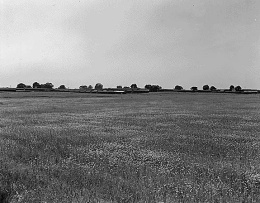 Media
Media

